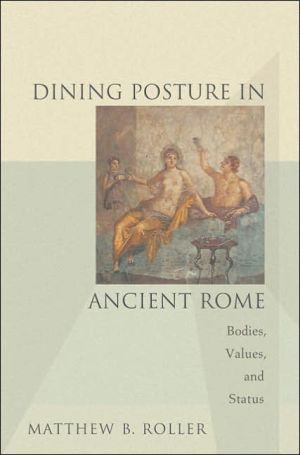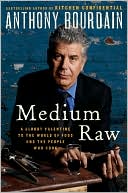Dining Posture in Ancient Rome: Bodies, Values, and Status
What was really going on at Roman banquets? In this lively new book, veteran Romanist Matthew Roller looks at a little-explored feature of Roman culture: dining posture. In ancient Rome, where dining was an indicator of social position as well as an extended social occasion, dining posture offered a telling window into the day-to-day lives of the city's inhabitants.\ This book investigates the meaning and importance of the three principal dining postures—reclining, sitting, and standing—in...
Search in google:
"A scholarly and significant book on an important aspect of Roman conviviality, written with clarity and elegance."--Oswyn Murray, University of Oxford"Matthew Roller is refreshingly challenging in his unwillingness to accept the communis opinio of scholarship while candid about the speculative character of many of his own conclusions. The book engages consistently and persuasively with past and current work on Roman dining and the topic is timely and sure to be of interest."--Anthony Corbeill, University of Kansas Emily Gowers - Times Literary Supplement Roller can justifiably claim to have pulled the cloth from under an old and inadequate model of ancient dining, and in the process drawn important conclusions about the wider issue of the self-definition of elites and non-elites in Rome. . . . [T]his stands out as a devoted, sophisticated and ambitious study of a central aspect of ancient culture.
Dining Posture in Ancient Rome\ Bodies, Values, and Status \ \ By Matthew B. Roller \ Princeton University Press\ Copyright © 2006 Princeton University Press\ All right reserved.\ ISBN: 0-691-12457-4 \ \ \ Introduction\ THE READER WHO TAKES this volume into her or his hands may marvel to behold a book-length study of posture in the Roman convivium-a topic that may appear, even to students of Roman social and cultural history, overly abstruse and specialized. Can the results of such an investigation really fill so many pages productively? Some preliminary justification seems worthwhile, lest anyone decide out of hand that the answer is no and abandon the book on principle. \ I therefore open with three brief examples, two literary and one visual. The first, a passage from Suetonius's fragmentary De Poetis, relates an anecdote about the comic playwright Terence. As a young poet on the verge of producing his first play (the Andria, staged in 166 B.C.), Terence was instructed by the aediles to submit the work to the venerable playwright Caecilius Statius for approval. He duly called upon the great poet, by chance arriving at his house while he was dining. Terence was admitted but was made to sit on a bench "because he was poorly clothed," while Caecilius himself reclined on a couch. But upon reading the opening verses, Terence so impressed his host that he was invited to recline on a couch andshare the meal, after which he read off the remainder of the play to Caecilius's great admiration.\ For current purposes, this anecdote makes two important points. First, it indicates that, among the parties who were present at this meal, at least two different postures could be assumed simultaneously: reclining and sitting. Second, it suggests that these postures were differently marked for status. Terence's "poor clothing"-"poor," one assumes, in the eyes of his host Caecilius, and in relation to the clothing that Caecilius himself (and his other guests, if any) wore-is given as the reason that he was initially required to sit on a bench, near but apart from the host's couch. And since it was only after making a good impression with his verses that Terence was invited to recline on a couch like his host and share the meal, it seems clear that the reclining posture is correlated with higher status and privilege, and the seated posture with lower. Thus, Terence's two postures objectify and make visible the social status(es) ascribed to him by his host: first, he sits apart from the other diners as a social inferior; then he reclines among them as a social equal. The transition from the one posture to the other, and from the margin to the center of the convivium, marks a social promotion that he earns by the quality of his poetry. Yet even when he sat, Terence was probably not at the bottom of the social hierarchy, even in this dining room. For any Roman reader of this anecdote would assume that household slaves were also present, attending to the needs of the host (their master) and his guests. As we shall see, such slaves would normally have been on their feet, either discharging their various tasks-pouring wine, clearing the tables, bringing food, and the like-or awaiting orders from the diners. To stand at dinner, then, and to be in motion, constitutes a third convivial posture marking a condition inferior even to that of a seated diner, let alone a reclining one.\ The second example is a passage from Isidore's Etymologiae, written in the seventh century A.D., which cites M. Terentius Varro, the polymath of the first century B.C., as an authority on archaic Roman dining practice. Isidore writes (Etym. 20.11.9), "Sedes ['seats'-i.e., places on the dining couches] are so called because among the old Romans there was no practice of reclining, for which reason they were also said to 'take a seat.' Afterward, as Varro says in his work On the Life of the Roman People, men began to recline and women sat, because the reclining posture was deemed shameful in a woman." In asserting that men's dining posture changed from sitting to reclining, while women's posture did not, Isidore and Varro suggest that Roman bodily practice in convivial settings had both a diachronic dimension (change occurred over time) and a gendered dimension (men's practice diverged from women's). This latter dimension, moreover, is implicated with social hierarchies and moral values in an ideologically potent way. For we may suspect, given the hierarchy of postures observed in Suetonius, that women who dined seated were thereby marked as socially subordinate to men who reclined. And Varro's remark that the reclining posture was "shameful" for women, but not for men, indicates that a given posture had a different moral valence depending on the sex of the person who assumed it.\ The third example is a funerary urn from the city of Rome, now in New York, dating to the Flavian period (A.D. 69-96; fig. 1). The relief that decorates the front of this urn shows a woman reclining on a couch. A small dining table sits before her, holding drinking vessels and items of food. Sitting in the middle of the couch is a smaller male figure wearing a toga (probably), his feet resting on a small podium; he and the woman are turned toward one another and extend their arms in reciprocal gestures. As I will argue in chapter 3.2, the inscription accompanying this scene, together with the overall form of the monument, gives us good grounds for supposing that the woman shown here is a freedwoman. The intimacy suggested by these figures' gestures and proximity might further lead us to suppose they are a mother and son, the latter probably freeborn. At the head and foot of the couch stand figures bringing food and wine for the table-certainly slaves, seemingly represented as small children. This scene calls to mind the hierarchy of postures observed in the passages of Suetonius and Isidore. Here, however, the hierarchy of free persons is apparently based on age, not gender or status at birth: a freedwoman reclines, presumably because she is an adult, while a freeborn male sits, presumably because he is a child. Moreover, the fact that a woman is shown reclining suggests that the norm described by Varro-that women in the good old days "properly" sat to dine-is not observed here. But why not? Should we infer that women's dining posture had changed over time? If so, would the associated norms also have changed so that reclining was no longer deemed "shameful" in a woman? Alternatively, might the practices and values of different social strata be different? For Varro probably refers to elite practices, while the people commemorated in this monument are not elites.\ These three examples adumbrate some of the interrelationships between status, values, and social practice that this book will examine; they also point toward some broader scholarly debates-in Roman studies proper, and among other humanists and social scientists-that this book engages. Let us take these in turn.\ Most obviously, this book participates in the upsurge of scholarly interest, over the past fifteen years, in Roman dining practices and foodways. The concerted attention of historians, archaeologists, and literary critics-most notably in the collections edited by Oswyn Murray (1990, 1995) and William Slater (1991), and in the work of particular scholars such as John D'Arms and Katherine Dunbabin-has greatly enhanced our understanding of the physical environments, social dynamics, and symbolic operations of the Roman convivium. One significant strand of this scholarship has examined how power relations among the diners are asserted, displayed, and contested. The positions assigned to the guests, the kinds of food and entertainment on offer, and even the give-and-take of convivial conversation all participate in the construction and maintenance of social hierarchies. Being concerned with how bodily bearing relates to social hierarchy, this book pursues this sociocultural approach. Yet we must characterize more precisely its contribution to this discussion, for scholars have long recognized that dining posture and social position are connected. Since the foundational work of Joachim Marquardt and August Mau in the 1870s and 1880s, culminating in the still-indispensable second edition of Das Privatleben der Römer (1886), a broad scholarly communis opinio has held that dining posture is correlated with gradations in age, sex, and social status, and that this correlation is as follows: free adult males-the most empowered and privileged social group-reclined on couches to dine; free adult women-"respectable" ones, at any rate-sat during the Republic but reclined during the Empire; free children, if present at all, sat; and slaves, at the bottom of the social scale, stood in service and at attention. This account of how posture, privilege, and participation are interrelated can be found, with small variations, in most handbook-style overviews of "everyday life" to which one might turn for basic information on Roman dining, and is repeated in many other studies by historians, literary critics, and archaeologists who rely upon these "handbook" discussions.\ There are at least three reasons, however, to be discontent with this schematization, reasons that are interrelated but distinguishable. First, it is based upon a very limited body of literary texts: the same dozen or so citations recur in the footnotes of every "handbook" discussion. In fact there are hundreds of texts providing representations of Roman convivial posture, and collectively they enormously complicate this simple view. The first passage cited here, for instance-in which Terence first sits separately to dine, then reclines along with his host-shows immediately that not all free adult males ipso facto dined reclining; under some circumstances, it appears that different postures, and different spatial relationships among bodies, articulated social hierarchies within the class of free adult males. I will adduce many texts that represent free adult males sitting or standing in the convivium, as well as reclining; also texts that represent slaves reclining or sitting, as well as standing; free children reclining as well as sitting; and free adult women reclining during the Republican period, when the handbooks say they sat. The complexity of this evidence taken as a whole will require us to seek explanations other, or further, than those that simply correlate posture with sex, gender, and age.\ A second reason for dissatisfaction with the communis opinio is that it ignores visual material. Images, like literary texts, provide crucial evidence for posture as a social practice, and for the values and ideologies associated with that practice. Their scope is also much broader than that of literary texts, which were mostly produced by, and primarily intended for the consumption of, a highly literate, predominantly male elite that was located in, well connected to, or socially and intellectually oriented toward the city of Rome. The visual material, in contrast, was mostly produced by, and intended primarily for the consumption of, sube-lites; its geographic provenance is also much broader. This material tells a quite different story from the mostly elite literary material, and it significantly alters our overall view of the practice and ideology of dining posture at Rome. Thus the funerary monument offered as the third opening example (fig. 1) raises a host of questions about Roman dining posture that could never emerge from literary representations. For example, even if this scene in certain respects "looks like" situations described in texts, is it valid to project the meanings and values associated with literary representations of elite dining onto the subelite diners commemorated in this monument? Does it matter that the people who commissioned this monument probably did not, in reality, have the economic resources to dine in the leisured, luxurious, elite style that this image portrays? And why put such a scene on a funerary monument in the first place? That is, why would an image of dining, with participants reclining, sitting, or standing, be used as a vehicle for commemorating a deceased freedperson? Because it brings subelites onto the agenda, the visual material raises many questions, and offers answers as well, about the practices and values associated with dining posture that literary texts do not on their own raise or answer.\ The third and perhaps most important reason to be discontent with the communis opinio will already be clear from the foregoing discussion. This is its failure to notice how dining posture is linked with social values and to consider what these linkages mean. The second example discussed here-the passage of Varro, asserting that early Roman women normatively dined seated, because reclining was deemed shameful-well illustrates the problem. This is one text that handbooks regularly cite, and on the basis of which they assert that Roman women in general dined seated during the Republic. But Varro is not simply describing social practice; he is also, or rather, linking dining posture with sexual mores. The suggestion that this antique social practice is an outward sign of antique moral virtue-which, by implication, is absent in the morally fallen present-is part of a "good old days" discourse, which should make us chary of accepting as historically true the practice so characterized. Indeed, as we shall see in chapter 2, many texts contradict this one (at least as it is usually interpreted) by representing Republican-era women reclining to dine just as men do, and indeed reclining right alongside the men. Conversely, early Imperial funerary monuments often show women dining seated, at a time when the handbooks say they reclined. It will become clear that women's dining posture is used in all periods, in both visual and literary media, as an index of moral status. What underlies many specific representations of women reclining (typically alongside men) or seated (at a distance from the reclining men) is not actual practice but profound anxieties about women's capacity for, and inclination toward, transgressive sex, which is inferred from their juxtaposition with male bodies and their proximity to wine. The broader point, moreover, holds true for men and children as well as for women. Dining posture in general-for diners of every status, age, and sex-is profoundly intertwined with key social values. Thus, upon assuming a particular posture and a particular relationship to other bodies, a diner associates certain values with herself or himself; conversely, a person to whom certain values are ascribed is thereby authorized to assume a particular dining posture.\ Consequently, the basic historical question of who assumed what posture when, cannot be answered by simply accepting at face value what the texts say or the images show. This is because most representations of dining posture in every medium are ideologically fraught: the postures that people are represented as assuming while dining have more to do with the values they seek to claim for themselves than with giving an authentic "snapshot" of actual social practice. To lack awareness of this ideological dimension, or to ignore its intricacies, vitiates any attempt to recover actual social practice. Yet at the same time, these ideological effects themselves presuppose that certain social practices do exist, or can plausibly be imagined to have existed at some time and place; thus ideological analysis requires a parallel analysis of practice, just as no analysis of practice can proceed in ignorance of ideology. The two dimensions refer to, presuppose, and symbiotically require one another. In this book, I develop an ideological analysis of representations of convivial posture at the same time as I develop an account of actual social practice-but the latter, being constructed in light of the former, will turn out quite differently from the account offered by the handbooks.\ (Continues...)\ \ \ \ \ Excerpted from Dining Posture in Ancient Rome by Matthew B. Roller Copyright © 2006 by Princeton University Press. Excerpted by permission.\ All rights reserved. No part of this excerpt may be reproduced or reprinted without permission in writing from the publisher.\ Excerpts are provided by Dial-A-Book Inc. solely for the personal use of visitors to this web site. \ \
List of Illustrations ix Acknowledgments xi Abbreviations xiii Introduction 1Chapter One: Dining Men: Posture, Leisure, and Privilege 15 1. Overview 15 2. Reclining and Elite Otium: Some Literary Evidence 16 3. Reclining and Social Integration: Subelite Funerary Monuments 22 4. Reclining and Self-Reflection: Pompeian Mural Decoration 45 a. Casa del Fabbro (I.10.7) 49 b. Casa dei Casti Amanti (IX.12.6-7) 61 c. VI.16.36 69 d. Casa del Triclinio (V. 2.4) 70 e. Provisional Conclusions: Subelites and Self-Reflection 77 f. Grand Houses 80 5. Alternative Postures and the Rejection of Otium 84 6. Conclusion: The Popina 92Chapter Two: Dining Women: Posture, Sex, and Status 96 1. Overview 96 2. Women's Dining Posture, Ideology and Practice: Literary Representations 98 a. Republican Period 99 b. Augustan Period 112 c. Imperial Period 118 3. Women's Dining Posture and Family Values: Subelite Funerary Monuments 123 4. Women's Dining Posture and Self-Reflection: Pompeian Mural Decoration 139 5. Conclusion: The Ideology and Practice of Women's Dining Posture 153Chapter Three: Dining Children: Posture, Pedagogy, and Coming-of-Age 157 1. Overview 157 2. Sitting Children 159 3. Reclining Children 169 4. General Conclusions 175Appendix: Convivial Wine Drinking and Comissationes 181 Catalogue of Funerary Monuments and Wall Paintings 189Bibliography 197 Index Locorum 209 General Index 215
\ Times Literary Supplement - Emily Gowers\ Roller can justifiably claim to have pulled the cloth from under an old and inadequate model of ancient dining, and in the process drawn important conclusions about the wider issue of the self-definition of elites and non-elites in Rome. . . . [T]his stands out as a devoted, sophisticated and ambitious study of a central aspect of ancient culture.\ \ \ \ \ Gastronomica - Carolyn Shank\ Roller's book not only achieves its goal of disproving the communis opinio regarding dining posture but also shows that a detailed study of such a topic has much to teach us about the Roman world.\ \ \ Journal of Roman StudiesDining Postures addresses a fascinating aspect of Roman social life which has never been given this amount of direct attention before. Its conclusions raise interesting questions and will open further debate; it is a provocative addition to the ever-growing bibliography on body language and social manners.\ \ \ \ \ Times Literary SupplementRoller can justifiably claim to have pulled the cloth from under an old and inadequate model of ancient dining, and in the process drawn important conclusions about the wider issue of the self-definition of elites and non-elites in Rome. . . . [T]his stands out as a devoted, sophisticated and ambitious study of a central aspect of ancient culture.\ — Emily Gowers\ \ \ \ \ GastronomicaRoller's book not only achieves its goal of disproving the communis opinio regarding dining posture but also shows that a detailed study of such a topic has much to teach us about the Roman world.\ — Carolyn Shank\ \ \ \ \ Journal of Roman StudiesDining Postures addresses a fascinating aspect of Roman social life which has never been given this amount of direct attention before. Its conclusions raise interesting questions and will open further debate; it is a provocative addition to the ever-growing bibliography on body language and social manners.\ — Mary Harlow\ \ \ \ \ Journal of Roman StudiesDining Postures addresses a fascinating aspect of Roman social life which has never been given this amount of direct attention before. Its conclusions raise interesting questions and will open further debate; it is a provocative addition to the ever-growing bibliography on body language and social manners.\ — Mary Harlow\ \ \ \ \ GastronomicaRoller's book not only achieves its goal of disproving the communis opinio regarding dining posture but also shows that a detailed study of such a topic has much to teach us about the Roman world.\ — Carolyn Shank\ \








